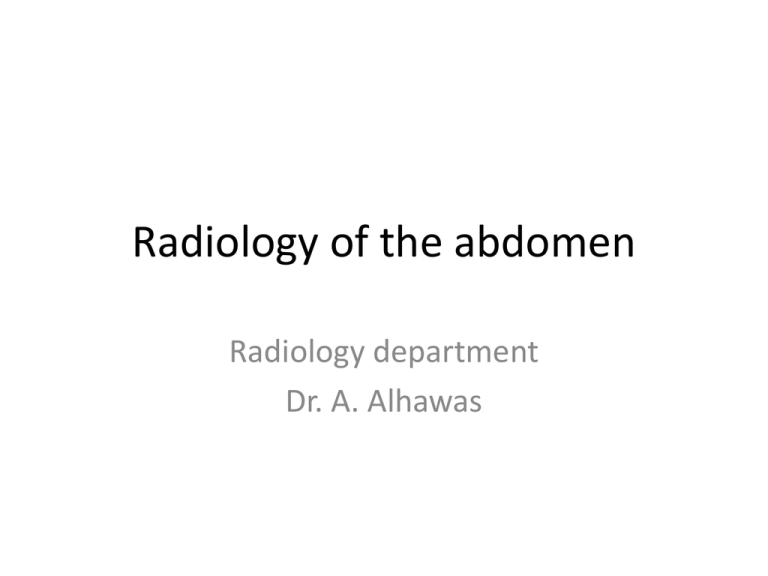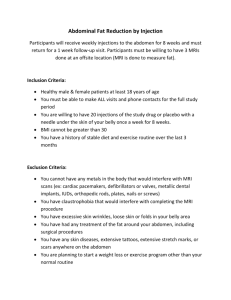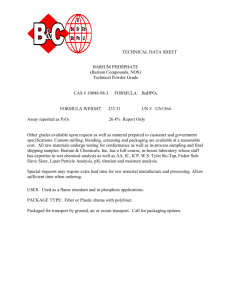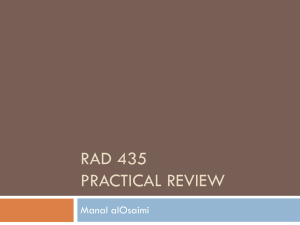Radiology of the abdomen
advertisement

Radiology of the abdomen Radiology department Dr. A. Alhawas Outline: • Imaging modalities used to study the abdomen. • Anatomy and normal appearance of the abdomen. • Common pathological cases. Imaging modalities: • • • • • • Conventional X-Ray. Barium studies ( flouroscopy ) US. CT. MRI. Nuclear medicine. Conventional Radiography (X-ray) • Often used as first imaging modality. • Cheap. • Useful for some radio-opaque stones and bowel obstruction and localization of the catheters. Radiograph (X-ray) • Image features: – Projectional image. – Image contrast determined by tissue density. – Good evaluation for the bones, bowel distension and constipation. – Can be portable. • Disadvantages: – Radiation ( minimal ). – Poor soft tissue contrast Barium studies ( fluoroscopy ) • Often used in GIT abnormalities. • Cheap. • Use barium or gastrographin. • Recently replaced by endoscopy and colonscopy. • Useful in assessing esophageal motility and small bowel. • Image features: – Projectional image. – Image contrast determined by tissue density and oral contrast. – good evaluation of GIT. • Disadvantages: – Radiation. – Poor soft tissue contrast It has many procedures such as: 1. Barium swallow. 2. Barium meal. 3. Small bowel follow through. 4. Small bowel enema 5. Barium enema. US • Ultrasound. • Use high frequency sound wave ( no radiation hazard ). • Contrast between tissue is determined by sound reflection, depend on nature of the organ and physical density. US • Good resolution. • Used to assess the liver, GB, vascular structures, kidneys, UB, pancreas and spleen. • Real time imaging and fast scan • Can be done portable. • Disadvatages: – Operator dependant. B mode: C mode : Computed Tomography ( CT ) • Same basic principle of radiography • More precise • costly. • Can not be done portable. • Useful for trauma, stone, tumor, infection. • Scan time usually takes few minutes ( 1 – 7 minutes ). CT: • Image features: • Cross sectional images. • Image contrast determined by tissue density +/- contrast. • Better evaluation of soft tissue. • Can assess vascular structures =) need I.V. contrast. • It is better than x- ray in assessment of ST and bones. MRI • Magnetic resonant imaging. • Better evaluation of soft tissue. • Expensive. • Useful for soft tissue pathology: • Tumor, infection, MRI • Use strong magnetic field. • Can not be done portable. • No radiation hazard. • The scan usually take long time ( 30 – 60 mins) • Very susibtible to motion and metallic objects. Nuclear medicine • Gama camera. • Radioactive isotopes. • Functional test (physiology). • very expensive. • Useful for: Assessing the active tumors, bone involvement and renal functions. Nuclear medicine • Image features: • Projectional image. • Image contrast by tissue uptake and metabolism. Objectives: • Introduction. • Imaging modalities used to study the back. • Anatomy and normal appearance of the abdomen. • Common pathological cases. CT MRI MRI Objectives: • Introduction. • Imaging modalities used to study the back. • Anatomy and normal appearance of the abdomen. • Common pathological cases. 50 y/o male patient presented with gradual abdomen distension. 24 Y/O patient presented with sudden pain in the epi-gastric area and back. 30 Y/O female patient presented with right upper quadrant pain. She had tendrness in the right subcostal margin. Lab test showing leukocytosis. Thickned wall Stone Comet tail.







